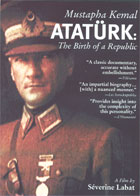
Mustapha Kemal Ataturk. The Birth of a Republic 2008
Distributed by Icarus Films, 32 Court St., 21st Floor, Brooklyn, NY 11201; 800-876-1710
Produced by Sophie Faudel
Directed by Severine Labat
DVD, color, 53 min.
College - Adult
Middle Eastern Studies, Political Science
Date Entered: 02/04/2009
Reviewed by Michael J. Coffta, Business Librarian, Bloomsburg University of PennsylvaniaThis intricate and meticulously assembled documentary gives a comprehensive record of the political life of Mustapha Kemal, first President of the Republic of Turkey, from his political rising beginning in 1909 to his death in 1938. The film offers extensive interviews with historians and social scientists, excellent and rare footage, and a finely detailed analysis of events. The audience receives full accounts of a series of party movements, coups, conspiracies, the rise and fall of labor unions, and the political intrigue that marked this general and statesman’s career.
Kemal’s life is replete with seeming contradictions. At the end of World War I, the Ottoman Empire, having allied with Germany, was disgraced in the aftermath of the Armenian extermination and in the face of Western occupation. Kemal, however, was considered by his countrymen to be a victorious general in an otherwise defeated alliance. Kemal eventually organized resistance to this occupation and became a national hero, ascending to the Presidency. On the other hand, Kemal silenced opposition groups with a great deal of bloodshed.
In 1926, he instituted a civil code promoting equality between the sexes, abolishing polygamy, and establishing other Western-influenced initiatives. To serve as a public example, Kemal had a civil wedding ceremony as opposed to a religious wedding. His government adopted the Latin alphabet, and struck specifically Muslim language from the constitution and other government documents, marking a break with the Arab world. Historians contemplate whether or not the positive outcomes of the Kemal regime would have been better accepted and widely known had his tactics been gentler. Nevertheless, he was responsible for this transformation, but in so doing created enemies within Turkey and throughout the Arab world. Despite becoming more authoritarian, he was genuinely interested in modernization and adopting Western democracy, even to the point of creating an opposition party to rival his own entrenched party. As the 1930s progressed, he promoted nationalist elitism, established a cult of personality, and adopted the patronym “Ataturk” or “father of the Turks,” which in no small way resembles Hitler’s title “Fuehrer.” Kemal died in 1938 on the brink of World War II. The “epilogue” of this film is concise yet provoking, as it demonstrates Kemal’s long term impact on Turkey.
The intricacy of this work is simply astounding. Its intense amount of detail, in addition to its dense spans of subtitles, may be difficult to follow for younger audiences. This outstanding work is highly recommended to those who want an advanced and comprehensive record of Turkey in the early 20th century.